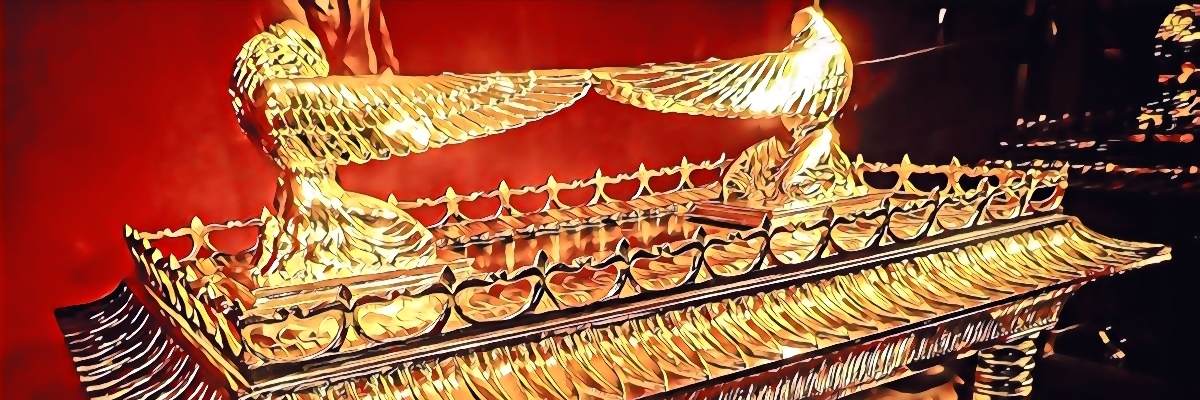Hunting for the lost Ark

According to the book of Exodus, after Moses delivered the Israelites from slavery in Egypt, God said, "They shall make an ark of acacia wood" and so the Israelites built an ark or chest covered with gold and surmounted with two golden-winged Cherubim facing each other. The Ark of the Covenant must have been an awesome object to behold. But what lay inside made it the holiest and most powerful of religious objects because inside Moses placed the stone tablets inscribed with the Ten Commandments.
The Ark is believed to wield supernatural powers. The Bible describes how, blazing with fire and light, it inflicted cancer-like tumours and severe burns on the enemies of Israel, levelled mountains, stopped rivers and laid waste to whole cities. It was the biblical equivalent of the atomic bomb. But, between 900 and 500BC, the Ark vanished from Jerusalem's First Temple making its loss one of the greatest mysteries of the Bible... But not to the Ethiopians.
THE GUARDIAN
The Ethiopian Orthodox Church worships a relic which they believe to be the true Ark. It rests in the Church of Saint Mary of Zion in the town of Aksum. It is protected by a Guardian - a Coptic priest who never leaves its side, and never allows anyone to see it, not even the Emperors of Ethiopia. Each of the country's other 20,000 churches keep a replica of the Ark, in a room known as the Holy of Holies - a church with out one is considered unconsecrated.
The earliest account of the Ark coming to Ethiopia is written in a sacred book called the Kebra Nagast, or Glory of Kings. The book tells how the Queen of Sheba conceived King Solomon's child while on a visit to Jerusalem. On her return to Aksum, she gave birth to a son, named Menelik. Some 20 years later, Menelik visited Jerusalem and spent a year at his father's court. On his departure, he stole the Ark and carried it off to Aksum.
In 1983, best selling author of 'The Sign and the Seal: A Quest for the Lost Ark of the Covenant', Graham Hancock, visited the chapel in Aksum, and asked the Guardian about the legend of the Ark. 'It was brought to Ethiopia, to this sacred city... here it has remained ever since,' the Guardian told Hancock. Others have spoken to the Guardian but none have since received an answer to their questions.
FACT OR FICTION
Professor Richard Pankhurst, a leading historian on the area, stated that while the legend of Solomon and Sheba had an ancient pedigree in Ethiopia, Sheba had almost certainly come from Arabia, not Ethiopia. More damning was that Aksum did not exist when Menelik was alive, as it was not founded until at least the 3rd century BC - about 700 years after his death.
The Old Testament, contains more than 200 references to the Ark up to the reign of Solomon (970-931BC). It was not mentioned again until 701BC and then again around 620BC, when two passages appear to convey that it was no longer in the First Temple. This meant that it could only have gone missing in the relatively brief 80-year period between 701 and 620BC.
THE ARK IS TAKEN
Further research suggests that the Ark could have been taken during the reign of King Manasseh (687-642BC) who had turned his back on Judaisin. Dr Menahem Haran, of Jerusalem's Hebrew University, suggests that priests loyal to the Judaic faith could have taken the Ark from Jerusalem around 650BC. At that time, Manasseh installed a pagan idol in the Temple and the priests were horrified at the prospect of the Ark being polluted by the presence of the idol so they took the Ark somewhere else for safekeeping.
In addition, German archeologists found records while excavating a site on Elephantine, an island in the Nile, indicating that a Jewish temple had been built around 650BC by priests fleeing from Manasseh. At that time, it was the only Jewish Temple in the world outside Jerusalem, built to serve exclusively as a 'house of rest for the Ark of the Covenant'.
However, after approximately 200 years the Temple was destroyed during a conflict with the local Egyptian community. At the same time, the Jews living on Elephantine seemed to have picked up their belongings and left with Archeologists having no idea where they might have gone.
A PLACE TO HIDE
Lake Tana in Ethiopia, the source of the Blue Nile, is dotted with hundreds of hard-to-reach islands - the ideal hiding places, perhaps, for the fleeing Jews of Elephantine.
Monasteries were built on the islands since AD300 and on one of the remote islands, Tana Kirkos, the monks insist that the Ark had been brought to there before it was moved to Aksum.
It is possible that, following the destruction of the temple on Elephantine, the Jewish migrants fled south, carrying the Ark with them. They followed the Nile river system through the deserts of the Sudan and into the highlands of Ethiopia, ending up at Lake Tana.
One monk stated, 'The Holy Ark stayed here on Tana Kirkos for 800 years". Later, King Ezana, who helped convert Ethiopia to Christianity in the 4th century AD, took the Ark to Aksum and placed it in the St. Mary of Zion cathedral.
AKSUM
On 19th January (20th in a leap year) is the annual ceremony of Timkat which celebrates the baptism of Jesus by John the Baptist in the River Jordan. At this time of year, the Ark is supposedly carried in the religious procession.
During the Timkat ceremony the priests carry a bulky rectangular chest, draped in thick blue cloth, embroidered with the emblem of a dove. But the chest is not covered in gold and there are no cherubim on top. It does not look like the Ark as described in the Bible. In addition, the Guardian of the Ark remains inside the chapel throughout the procession, which seems odd given the sacred trust bestowed on him to guard the Ark.
CONFLICTING ACCOUNTS
Other researchers claim to have found the Lost Ark of the Covenant, but not all the claims stand up to close scrutiny.
Supposedly, a scholar named Edward Ullendorff saw the Ark in St. Mary of Zion cathedral during World War II and found that it was not the original Ark.
The Institute for Restoring Ancient History says it found the Ark in a cave on Mount Nebo, Jordan, in October 1981. However, the Jordanian government refuses to allow anyone to remove the artefact from the cave. So, no independent researcher can validate or disprove their claim.
Ron Wyatt, from Nashville Tennessee, says he found the Ark near Ashkelon, in Israel, in January 1982. He had been excavating a site for three years, beneath the spot where Jesus was supposed to have been crucified. Wyatt took photographs of the Ark, but claims they were miraculously clouded when the film was developed. He traced the outline of the Ark on to one of the photographs.
In 2019, Religious archaeologists from Tel Aviv University in Israel claimed to discover the stone on which Ark of Covenant once sat, a 12th century temple near the modern-day town of Beit Shemesh.
Needless to say, no conclusive evidence exists to the whereabouts of the Ark of the Covenant, so the mystery lives on.

